W.E. Patt. '08 Equipment Carriers
Carriers, intrenching tool
The Carrier, intrenching tool, head, and Carrier, intrenching tool, helve, were added to the components of W.E. Patt. '08 by List of Changes entry §14795, dated 17th May 1909, 24th August 1909, and 8th October 1909. These items were designed to carry the Implement, intrenching, pattern 1908, introduced by List of Changes entry §14796, dated 22nd October 1908, 23rd July 1909, and 8th October 1909. This pattern of tool was adapted from the Sirhind Tool used by the Indian Army.
Note on spelling - In the original List of Changes entry for the Carrier, intrenching tool, and in most (but not all) official documentation until about 1939, the word is spelled "intrenching". Occasionally, though the spelling "entrenching" slips in, apparently depending on the whim of the War Office clerk on duty at the time. Following the 1939 reintroduction of the Sirhind tool as "Implements, entrenching, 1937 pattern", the "en-" spelling has become today's norm. I have taken a "neither here nor there" approach to this problem. In direct quotations I've used the original spelling, whilst in references to the item itself I've taken the conventional "en-" usage.
Carriers, intrenching tool, Mills-Burrowes

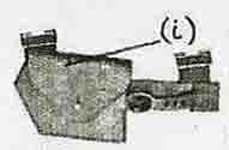
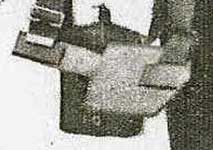 In the trials Mills-Burrowes Web Equipment, neither the Sirhind tool nor its Carriers had reached their final forms. The Mills-Burrowes pictures shown left appeared in a broadside Fitting Instructions issued by the Mills Equipment Company c. mid-1909. This broadside states that the type of Intrenching tool had yet to be decided, and that the final version of the Carrier would depend on its selection. In this early state, the Tool head was carried in a leather pouch with 2-inch web straps, whilst the Helve was carried in leather straps sewn to the bayonet scabbard.
In the trials Mills-Burrowes Web Equipment, neither the Sirhind tool nor its Carriers had reached their final forms. The Mills-Burrowes pictures shown left appeared in a broadside Fitting Instructions issued by the Mills Equipment Company c. mid-1909. This broadside states that the type of Intrenching tool had yet to be decided, and that the final version of the Carrier would depend on its selection. In this early state, the Tool head was carried in a leather pouch with 2-inch web straps, whilst the Helve was carried in leather straps sewn to the bayonet scabbard.
Carrier, intrenching tool, helve
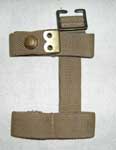
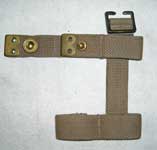
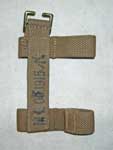
![]() The Carrier, intrenching tool, helve, is a simple arrangement of three 1-inch straps sewn into four loops, one of which can be opened and closed with a press stud. The two fixed loops on the right, in front of the vertical strap, are passed over the Bayonet scabbard. The buckle attached to a tab sewn to the back of the Frog. The Helve is carried in the two straps on the left, so that it is in front of the scabbard when the assembly is in worn on the left side. The illustration of the Helve holder assembly provided in L. of C. §14795 (right) clearly shows an early Patt. '08 style straight brass tip on the closure strap. The text, though, reads "[t]he part of the top loop which passes round the helve is fitted with two brass eyeletted tips and a fastener." It may be that the picture provided was of a prototype example, and that production Helve holders were fitted with eyeletted tips. The Tool head carrier shown in the same illustration has an eyeletted tip on its closure strap, as does the 1908 dated example shown below. Looking at the entry and amendment dates on L. of C. §14795, it is apparent that both the Helve holder and Tool head carrier were entered into the List of Changes well before L. of C. entry §15048, dated 22nd November 1909, but apparently not actually appearing in the List until 1st June 1910. This entry replaced the plain brass tips on all Patt. '08 tabs ands straps with eyeletted ones.
The Carrier, intrenching tool, helve, is a simple arrangement of three 1-inch straps sewn into four loops, one of which can be opened and closed with a press stud. The two fixed loops on the right, in front of the vertical strap, are passed over the Bayonet scabbard. The buckle attached to a tab sewn to the back of the Frog. The Helve is carried in the two straps on the left, so that it is in front of the scabbard when the assembly is in worn on the left side. The illustration of the Helve holder assembly provided in L. of C. §14795 (right) clearly shows an early Patt. '08 style straight brass tip on the closure strap. The text, though, reads "[t]he part of the top loop which passes round the helve is fitted with two brass eyeletted tips and a fastener." It may be that the picture provided was of a prototype example, and that production Helve holders were fitted with eyeletted tips. The Tool head carrier shown in the same illustration has an eyeletted tip on its closure strap, as does the 1908 dated example shown below. Looking at the entry and amendment dates on L. of C. §14795, it is apparent that both the Helve holder and Tool head carrier were entered into the List of Changes well before L. of C. entry §15048, dated 22nd November 1909, but apparently not actually appearing in the List until 1st June 1910. This entry replaced the plain brass tips on all Patt. '08 tabs ands straps with eyeletted ones.
At this time, all that can be said is that there may have been two issues of the Helve holder, the first having plain brass tips on the securing strap. If anyone can supply pictures (or an actual example!) of a Helve holder with plain brass tips, I would be very happy to publish them here. The Helve holder, along with the Patt. '08 Intrenching tool, Helve, and the Tool head carrier, were declared obsolete by List of Changes entry §25979, dated 6th September 1923. This example is maker marked "M.E. Co." and dated 1915. From the Karkee Web Collection.
This picture shows the Frog and Helve holder assembled together with a Pattern 1907 Bayonet and the Pattern 1908 Intrenching tool helve. From the Karkee Web Collection.
Carrier, intrenching tool, head
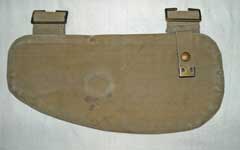
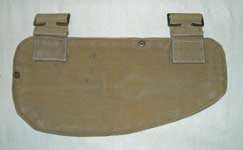
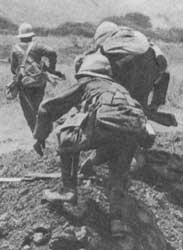 The Carrier, intrenching tool, head, as it was finally introduced is a simple, kidney shaped web bag with two 2-inch chapes. It is held closed by a web tab with fastener crown, and a fastener spigot on the body. The bag is lined with white or tan canvas. When it is carried in the standard position, the Carrier is worn on the right side, attached to the 2-inch strap on the right Cartridge carrier at the front, and to the rear end of the Brace at the back. It could be worn in other locations as well. The official fitting instruction booklet published by the War Office in 1913, Pattern 1908 Web Infantry Equipment, states "With the exception of the pack, which, when worn, must always be on the back, the articles carried by the soldier can be disposed in a variety of ways." Great War pictures often show the Entrenching tool carrier attached to the rear ends of both Braces, worn in a comfortable position at the back. The troops in picture at right, showing the Royal Navy Brigade at Gallipoli, are wearing their Entrenching tool carriers in this way. On the other hand, Barnsley Pal Private Frank Lindley, in a reminiscence of going over the top at the Somme, wrote "We had our entrenching tools strapped low across our fronts. They should have been fitted at the back but we used to strap them across the front to protect our privates from a bayonet thrust or a piece of shell or owt." [Quoted from Richard von Emden's splendid book Boy Soldiers of the Great War, p.202.] The example Carrier, intrenching tool, head, shown here is maker marked "M.E. Co." and dated 1911. From the Karkee Web Collection.
The Carrier, intrenching tool, head, as it was finally introduced is a simple, kidney shaped web bag with two 2-inch chapes. It is held closed by a web tab with fastener crown, and a fastener spigot on the body. The bag is lined with white or tan canvas. When it is carried in the standard position, the Carrier is worn on the right side, attached to the 2-inch strap on the right Cartridge carrier at the front, and to the rear end of the Brace at the back. It could be worn in other locations as well. The official fitting instruction booklet published by the War Office in 1913, Pattern 1908 Web Infantry Equipment, states "With the exception of the pack, which, when worn, must always be on the back, the articles carried by the soldier can be disposed in a variety of ways." Great War pictures often show the Entrenching tool carrier attached to the rear ends of both Braces, worn in a comfortable position at the back. The troops in picture at right, showing the Royal Navy Brigade at Gallipoli, are wearing their Entrenching tool carriers in this way. On the other hand, Barnsley Pal Private Frank Lindley, in a reminiscence of going over the top at the Somme, wrote "We had our entrenching tools strapped low across our fronts. They should have been fitted at the back but we used to strap them across the front to protect our privates from a bayonet thrust or a piece of shell or owt." [Quoted from Richard von Emden's splendid book Boy Soldiers of the Great War, p.202.] The example Carrier, intrenching tool, head, shown here is maker marked "M.E. Co." and dated 1911. From the Karkee Web Collection.
 The Carrier, intrenching tool, head, was officially entered into the List of Changes in May of 1909. However, the photo at left shows a Mills made Carrier dated 1908. This particular Carrier has documented provenance back to the 1980's that makes it extremely unlikely that the date stamp is other than genuine. Also note that the securing strap has an eyeletted brass tip. If that feature is original to the piece it would make this Carrier unique in our experience, as all other 1908 dated pieces of W.E., Patt. '08 that KW have seen have had plain brass tips. As has been discussed, the List of Changes entry sometimes follows the actual introduction of a piece of equipment, occasionally by months or even years. This may be what happened in this instance. This photograph courtesy of Great War Militaria.
The Carrier, intrenching tool, head, was officially entered into the List of Changes in May of 1909. However, the photo at left shows a Mills made Carrier dated 1908. This particular Carrier has documented provenance back to the 1980's that makes it extremely unlikely that the date stamp is other than genuine. Also note that the securing strap has an eyeletted brass tip. If that feature is original to the piece it would make this Carrier unique in our experience, as all other 1908 dated pieces of W.E., Patt. '08 that KW have seen have had plain brass tips. As has been discussed, the List of Changes entry sometimes follows the actual introduction of a piece of equipment, occasionally by months or even years. This may be what happened in this instance. This photograph courtesy of Great War Militaria.
Carrier, intrenching tool, head, Second issue
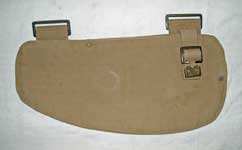
 The pattern for Carrier, intrenching tool, head, was altered by List of Changes entry §17808, dated 3rd July 1916. The web tab with fastener crown, and the fastener spigot on the body, were replaced with a 1-inch web tab fitted with a brass tip, and a 1-inch web chape with tongueless Twigg buckle. Following this modification, the Carrier remained unaltered for the remainder of its service life. The example shown here is maker marked "M.E. Co." and dated 1918. From the Karkee Web Collection.
The pattern for Carrier, intrenching tool, head, was altered by List of Changes entry §17808, dated 3rd July 1916. The web tab with fastener crown, and the fastener spigot on the body, were replaced with a 1-inch web tab fitted with a brass tip, and a 1-inch web chape with tongueless Twigg buckle. Following this modification, the Carrier remained unaltered for the remainder of its service life. The example shown here is maker marked "M.E. Co." and dated 1918. From the Karkee Web Collection.
Carrier, intrenching tool, head, Naval marked
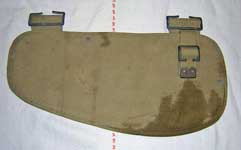
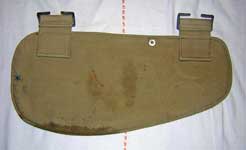
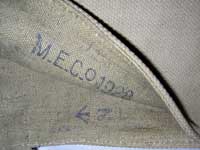 This Carrier, intrenching tool, head, is a perfectly normal example of the second issue in every way except its markings. List of Changes entry §25979, dated 6th September 1923, declared the Implements, intrenching, Pattern '08, heads and helves, and the Carriers, intrenching tools, heads and helves, obsolete in accordance with Army Order 267/1923. The L. of C. entry states that the Tool and its Carriers are declared obsolete by Army Order, but the entry is not coded with the "L" code that would indicate that this applies to Land Use Only. The existence of this Carrier suggests that this may be the case, however. It is maker marked "M.E. Co." and dated 1928. This in itself would not be too surprising, because the Mills Company made web equipment not just for the British Military, but also for other countries and other military and para-military groups. This Carrier, though, is also marked with the Broad Arrow/N/number inspection mark used by the British Navy. This suggests that the Implements, intrenching, Patt. '08, and the Carriers, intrenching tools, Patt. '08, were still in use by the Navy well after the Army had decided that they were no longer required. This example, from the Karkee Web Collection, is not unique. A small lot of Entrenching tool carriers turned up in Malta in 2007; several of them were Naval marked and dated 1928.
This Carrier, intrenching tool, head, is a perfectly normal example of the second issue in every way except its markings. List of Changes entry §25979, dated 6th September 1923, declared the Implements, intrenching, Pattern '08, heads and helves, and the Carriers, intrenching tools, heads and helves, obsolete in accordance with Army Order 267/1923. The L. of C. entry states that the Tool and its Carriers are declared obsolete by Army Order, but the entry is not coded with the "L" code that would indicate that this applies to Land Use Only. The existence of this Carrier suggests that this may be the case, however. It is maker marked "M.E. Co." and dated 1928. This in itself would not be too surprising, because the Mills Company made web equipment not just for the British Military, but also for other countries and other military and para-military groups. This Carrier, though, is also marked with the Broad Arrow/N/number inspection mark used by the British Navy. This suggests that the Implements, intrenching, Patt. '08, and the Carriers, intrenching tools, Patt. '08, were still in use by the Navy well after the Army had decided that they were no longer required. This example, from the Karkee Web Collection, is not unique. A small lot of Entrenching tool carriers turned up in Malta in 2007; several of them were Naval marked and dated 1928.
Carrier, intrenching tool, head
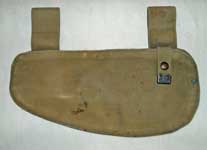
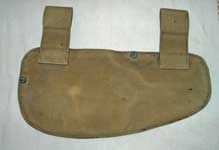 This Carrier, intrenching tool, head, is a variation of the Patt. '08 form in which the 2-inch chapes and buckles have been replaced with 2-inch web loops sized to fit a 1 3/4-inch wide belt. The Carrier has not been modified; it was constructed in this fashion. The consensus among collectors who have examined it is that probably was intended to be used with the Bandolier Equipment, Pattern 1903. See the Associated Equipment page in the B.E. Patt. '03 section for a discussion of this interesting Carrier. It is maker marked "M.E. Co." and dated 1911. From the Karkee Web Collection.
This Carrier, intrenching tool, head, is a variation of the Patt. '08 form in which the 2-inch chapes and buckles have been replaced with 2-inch web loops sized to fit a 1 3/4-inch wide belt. The Carrier has not been modified; it was constructed in this fashion. The consensus among collectors who have examined it is that probably was intended to be used with the Bandolier Equipment, Pattern 1903. See the Associated Equipment page in the B.E. Patt. '03 section for a discussion of this interesting Carrier. It is maker marked "M.E. Co." and dated 1911. From the Karkee Web Collection.
Carrier, intrenching tool, head
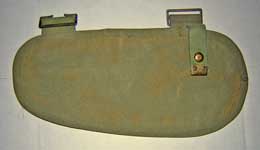
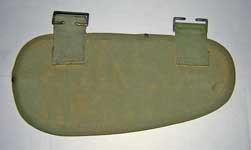 Another unusual Carrier, intrenching tool, head. This example is slightly larger than a standard Patt. '08 Carrier, and is selvedged all around with a thin web strip. The bag's general shape is also more rounded than usual, although it must be said that this does tend to vary from case to case regardless. It is maker marked "M.E. Co." and dated 1917. we have examined this Carrier closely and are convinced that it's genuine, albeit non-standard. It's been suggested that it may be a Private Purchase item, and perhaps this is correct - it is not broad arrow marked, and little information about Mills Private Purchase Equipment seems to have survived. From the Karkee Web Collection.
Another unusual Carrier, intrenching tool, head. This example is slightly larger than a standard Patt. '08 Carrier, and is selvedged all around with a thin web strip. The bag's general shape is also more rounded than usual, although it must be said that this does tend to vary from case to case regardless. It is maker marked "M.E. Co." and dated 1917. we have examined this Carrier closely and are convinced that it's genuine, albeit non-standard. It's been suggested that it may be a Private Purchase item, and perhaps this is correct - it is not broad arrow marked, and little information about Mills Private Purchase Equipment seems to have survived. From the Karkee Web Collection.
Carrier, entrenching tool, head
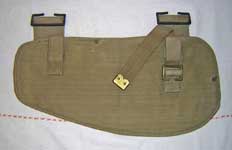
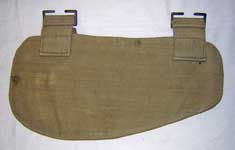
 This interesting variant is identical to the first issue Entrenching tool carrier issued with W.E. Patt. '37 , except that is has 2-inch buckled chapes instead of the 1-inch ones found on Pattern '37. Because the buckles on Carriers issued with Patt. '37 are quite often modified to 2-inch ones for reenactors, two members of the KW team examined this piece very closely. Our opinion is that it is in fact genuine, and was originally made just as it is shown. The sewing does look a bit odd in the interior photo, but a close examination reveals that this is because it is was sewn with khaki thread on the outside and white thread on the inside. Several examples of this Carrier turned up in Malta in 2009, and this one is typical. Whilst this type of Carrier has not, to KW's knowledge, been reported previously, it makes sense that it would exist. The Implement, intrenching, Patt. ’08, was reintroduced by L. of C. §B5409 in 1941, as the Implement, entrenching, Patt. ’37, after having been declared obsolete by Loc §25979 in 1923. This Carrier, identical to the Patt. '37 except for the 2-inch buckles, would seem to be a logical requirement for troops still using W.E. Patt. '08. This example is maker marked "BAGCRAFT LTD." and dated 1941. From the Karkee Web Collection.
This interesting variant is identical to the first issue Entrenching tool carrier issued with W.E. Patt. '37 , except that is has 2-inch buckled chapes instead of the 1-inch ones found on Pattern '37. Because the buckles on Carriers issued with Patt. '37 are quite often modified to 2-inch ones for reenactors, two members of the KW team examined this piece very closely. Our opinion is that it is in fact genuine, and was originally made just as it is shown. The sewing does look a bit odd in the interior photo, but a close examination reveals that this is because it is was sewn with khaki thread on the outside and white thread on the inside. Several examples of this Carrier turned up in Malta in 2009, and this one is typical. Whilst this type of Carrier has not, to KW's knowledge, been reported previously, it makes sense that it would exist. The Implement, intrenching, Patt. ’08, was reintroduced by L. of C. §B5409 in 1941, as the Implement, entrenching, Patt. ’37, after having been declared obsolete by Loc §25979 in 1923. This Carrier, identical to the Patt. '37 except for the 2-inch buckles, would seem to be a logical requirement for troops still using W.E. Patt. '08. This example is maker marked "BAGCRAFT LTD." and dated 1941. From the Karkee Web Collection.

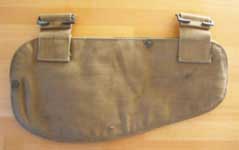
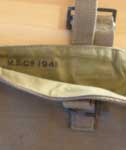 Another example of this type of Carrier has been reported. As with the previous example, it is 1941 dated. but this example is maker marked "M.E. Co." From the Richard Knight Collection, photos © Richard Knight 2012.
Another example of this type of Carrier has been reported. As with the previous example, it is 1941 dated. but this example is maker marked "M.E. Co." From the Richard Knight Collection, photos © Richard Knight 2012.
